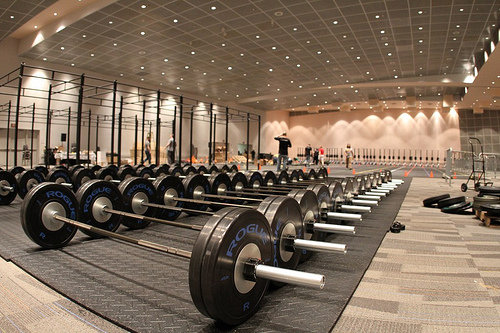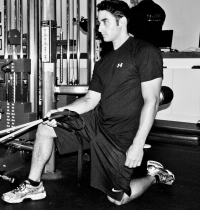Hacking the New Exercise Learning Curve


By Jonathan Goodman
Imagine you’re in a box. This box is your home and you haven’t ever been outside. The only things you know to exist are the exercise wheel, a bed and that odd, seemingly omnipotent, hand that comes in at regular intervals with food.
The bed in your box comes complete with a mattress, pillow, and blanket. But something odd is afoot. That same hand that brings you food comes in, at regular intervals, and takes a part of your bed away every day until you’re left with a frame. Then it brings you a different frame, one you’ve never seen before, but a frame nonetheless. At what point would you stop recognizing that the frame represents a bed?
The concept above is a description of studies that were performed using rats grown in a laboratory. As it turns out, rats that were never exposed to the outside world identified shapes they had never seen before as a bed. They associated structures unfamiliar to them as a place to sleep because of the similarities to the bed they already knew.
The theory is called associative learning and I’m going to show you how to apply it to hack the exercise learning curve.
In an attempt to conserve energy our brain forms associations between two experiences or stimuli that reinforce each other. It’s sub-conscious. We identify movements and categorize them. This way the brain doesn’t have to work from scratch each time we attempt to learn something new.
A Squat is a squat is a squat (even on an exercise ball)
One walk through a commercial gym and you see all sorts of whacky stuff. There are balls, hammers, tires, machines that ellipse, machines that move the ground so you can walk without going anywhere and, of course, the good, old-fashioned, dumbbell. Inevitably, on a simple walk around, you will see brand new exercises being performed.
On one hand you can gasp in horror and make fun of it on Facebook. On the other hand, you can marvel in the fact that, without any extra work, you knew exactly what the person was trying to accomplish. The dude doing a pistol squat on one leg while holding a ketllebell is doing squats. You know this because the general movement is the same, even if you’ve never seen a pistol squat before.
I believe there are 4 base movements that everything else in the gym builds upon by association. They are the:
-
Squat
-
Deadlift
-
Upper Body Push
- Upper Body Pull
It is a simplified and somewhat rudimentary approach; every exercise, when you boil it down, is one of these four movements. That’s why it surprises me that so few have taken the time to learn how to do these basic movements well. It’s not because I think you should perform the basic exercises all the time; it is because, in learning a few fundamental aspects of the basics, you greatly decrease the learning curve for every movement that follows.
In order to hack your exercise-learning curve in the gym, break down these four movements. Figure out the main cues that, when done correctly, make the exercise fall in place. Whenever you read an article or book with a new exercise it’s then a placing the movement into one of the four aforementioned categories. With the new implement or stance all you have to do is remember the initial cues and form the association.
The cues I’m about to teach you were ones I used with my clients; you might have different ones which isn’t a problem, do what works for you. I developed this system to make my job of coaching easier. Within 4 weeks of training a new client I stopped having to teach. I would demonstrate an exercise twice and they would copy, knowing exactly what body parts to fire and when. What followed was a system of perfecting the movement patterns with the main cues in mind.
Hacking the Squat
My cues for hacking the squat movement are to squeeze the shoulder blades together, lower yourself with control, and flex your glutes hard at the top. After years of coaching I found that these cues helped people control the movement and had them aligned properly. Once they developed these cues as habit I knew they were safe and we started on performance.
Variations of squatting can get complicated and higher performance is, of course, much more intricate than what I described above. When learning a new type of squat the 3 cues I gave above will force your body into the correct position. Your body already knows how to sit down; it’s been doing it for years. The squat variations are just another associated branch. And what about the pistol squat with a kettlebell? Yet another branch.
Hacking the Deadlift
Deadlifting is deadlifting. Whether you perform an RDL (Romanian deadlift), a sumo deadlift, a conventional deadlift, or even a single leg RDl holding a weight in one hand the basics of the movement are the same.
Take your time to learn how to brace through the abs (pretend you’re about the get punched in the stomach), keep your weight back on your heels, and extend at the hips at the top. Foot orientation or position of the implement becomes secondary considerations. They’re important but are accessory to what should have already become habit.
Hacking the Upper Body Push
I’m constantly surprised at how many variations people come up with to do the same. Damn. Thing. You can do a vertical or horizontal upper body press. I’ve lumped them together because of the similarities in terms of learning the movement.
My secrets are to grip the weight as hard as possible to pack the shoulder, focus on keeping tension between the shoulder blades on the way down, and squeezing the chest or shoulder on the way up (for horizontal and vertical presses respectively). Keep these 3 things in mind and you’ve hacked the upper body press. No go forth and invent yet another way to press a weight away from your body.
Hacking the Upper Body Pull
Pulling with the arms and not the back is a big mistake. If you look down at your shoulder at the end of a row and it’s poking forward you probably didn’t do it properly.
In order to learn any type of pull keep the following in mind: before initiating the movement roll your shoulders back and create tension between the shoulder blades, feel the movement through the middle of your back and not in your arms or shoulders (concentrate, this can take some work), and keep tension between the shoulder blades even at the end of the movement.
Different grips are important to get the most out of rowing movements. Keep my cues in mind whenever you try a new one.
Nothing is New
I’ve been to 10+ seminars, workshops, or conferences each year for the past 8 years. Every time I’m amazed at how many different ways trainers have discovered to accomplish the same task. True, different muscles are worked with different stances, implements, or if the exerciser is unbalanced and different energy systems can be at play; all of the fancy exercises can all be boiled down to four basic movements.
These variations are fun and present a challenge. I encourage you to explore all types of exercises. Get your cues down and enjoy hacking your exercise learning curve.
ABOUT THE AUTHOR

Jonathan Goodman is the author of Ignite the Fire: The Secrets to Building a Successful Personal Training Career. He started and still operates the Personal Trainer Development Center which acts as the largest free collaborative blogging website for personal trainers. Recently Jon stopped training clients in Toronto, Canada to focus on developing resources with the goal of improving the quality of personal training as an industry.
Website: http://www.theptdc.com
Facebook: http://www.facebook.com/theptdc
Twitter: http://www.twitter.com/jon_ptdc
